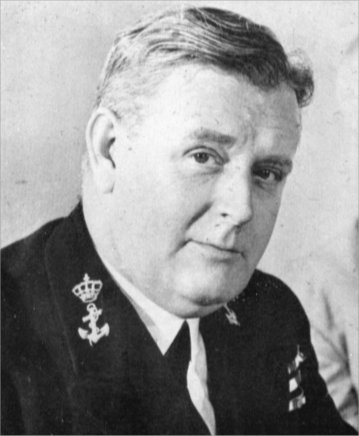Admiral Johannes Theodorus Furstner
Born Amsterdam January 16, 1887 - Died The Hague September 15, 1970
 Furstner would become the central figure in the Royal Netherlands Navy both in the late 1930s as during the Second World War. He attended the Higher Military School during 1919-1924, and immediately became a teacher at the newly erected Netherlands Naval War College. During 1927/1928, he attended the French École de Guerre Navale in Paris where he came under the influence of the famous maritime theorist Raoul Castrex, whose thinking was based on the theories of Mahan. This included how to successfully attack a more potent enemy with a small force, which was exactly the position the RNN was in at the time. Furstner's appointment as Director of the High Naval Academy allowed him to spread his views among the officers attending this school between 1930 and 1936. After becoming Chief of the Naval Staff in 1936, he was the principal figure in Dutch prewar planning and operations. The plan to construct three battlecruisers was sparked by a note he submitted in December 1938. Furstner would become the central figure in the Royal Netherlands Navy both in the late 1930s as during the Second World War. He attended the Higher Military School during 1919-1924, and immediately became a teacher at the newly erected Netherlands Naval War College. During 1927/1928, he attended the French École de Guerre Navale in Paris where he came under the influence of the famous maritime theorist Raoul Castrex, whose thinking was based on the theories of Mahan. This included how to successfully attack a more potent enemy with a small force, which was exactly the position the RNN was in at the time. Furstner's appointment as Director of the High Naval Academy allowed him to spread his views among the officers attending this school between 1930 and 1936. After becoming Chief of the Naval Staff in 1936, he was the principal figure in Dutch prewar planning and operations. The plan to construct three battlecruisers was sparked by a note he submitted in December 1938.
After Germany invaded and subdued Holland in a mere four-day struggle, Furstner managed to escape Holland by fishing boat. After arriving in London, he organized the remnants of the Dutch fleet. In doing this, his focus was on the loyal cooperation with the British Royal Navy in the fight against Germany. He became Minister of Navy in July 1941, after this particular branch was seperated from the Ministry of Defence. He retired in 1945, and became a member of the State Council, from which he retired in 1962.
| Ranks |
| Midshipman 1st class |
September 16 1906 |
| Lieutenant |
September 16, 1908 |
| Lieutenant-Commander |
September 1, 1918 |
| Commander |
December 14, 1928 |
| Captain |
March 27, 1933 |
| Rear-Admiral |
January 1, 1936 |
| Vice-Admiral |
January 1, 1938 |
| Admiral |
February 15, 1942 |
| Retired |
August 25, 1945 |
| Postings |
| Student, Netherlands Naval War College |
1918 |
- |
1920 |
| Teacher, Netherlands Naval War College |
November 1, 1921 |
- |
August 21, 1924 |
| Artillery officer, light cruiser Hr.Ms. Java |
1925 |
- |
1927 |
| Student, Ecole Supérieure de Guerre, Paris |
1927 |
- |
1928 |
| Executive officer, armored ship Jacob van Heemskerck |
1929 |
- |
|
| Director, Netherlands Naval War College |
September 15, 1930 |
- |
July 1, 1936 |
| Commanding officer, Hr.Ms. Hertog HendriK |
1935 |
- |
1936 |
| Chief of Naval Staff, Ministry of Defence |
July 1, 1936 |
- |
May 14, 1940 |
C-in-C, Dutch naval forces
(Bevelhebber der Zeestrijdkrachten, or BdZ), London |
May 15, 1940 |
- |
August 1945 |
| Minister of Navy |
July 27, 1941 |
- |
February 23, 1945 |
| Other activities |
| Member of the State Council |
August 25, 1945 |
- |
1962 |
| Awards |
| Dutch |
Commodore in the Order of the Dutch Lion (NL.2)
Officer in the Order of Orange Nassau (ON.4)
Honorary sign for important undertakings: Sunda islands 1905-1909 (E.17)
Coronation Medal 1948 (IM.1948)
Mobilization Cross 1914-1918 (Mk)
Service Cross for naval officers, for 30 years' of service (XXX) |
| Foreign |
Knight Commander of the Bath (KCB) (Britain)
Large cross in the Order of the Crown of Belgium (Belgium)
Commodore 2nd class in the Sword Order of Sweden (Sweden) |
|
![]()
![]()
![]()
![]()